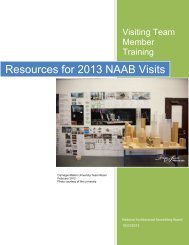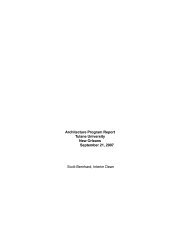NAAB Architecture Program Report (APR) 2013 - Tulane School of ...
NAAB Architecture Program Report (APR) 2013 - Tulane School of ...
NAAB Architecture Program Report (APR) 2013 - Tulane School of ...
You also want an ePaper? Increase the reach of your titles
YUMPU automatically turns print PDFs into web optimized ePapers that Google loves.
<strong>Tulane</strong> University<strong>Architecture</strong> <strong>Program</strong> <strong>Report</strong>September <strong>2013</strong>Strategic Priorities to Guide the ProcessMissionThe mission <strong>of</strong> the <strong>Tulane</strong> <strong>School</strong> <strong>of</strong> <strong>Architecture</strong> is to prepare students for leadership positions in thedesign pr<strong>of</strong>essions and in their communities. This school aspires to provide the highest qualitypr<strong>of</strong>essional education in architecture, to develop and conserve knowledge, and to promote excellenceand innovation in architecture, landscape urbanism, preservation, and urban and environmental designand development. The <strong>School</strong> aspires to reach many students within and beyond Richardson MemorialHall (RMH) through undergraduate minors in <strong>Architecture</strong>, a Certificate in Preservation, and through theminor in Social Innovation and Social Entrepreneurship (SISE). The <strong>School</strong> recognizes the centrality <strong>of</strong>“design thinking” as a process <strong>of</strong> synthesis that incorporates history, theory, technology, economics,behavior, and culture. The <strong>School</strong> supports diversity and meaningful engagement with urban andcommunity issues, while embracing the creative potential and imperative <strong>of</strong> sustainable design.I. Building Opportunity – Community Buildinga. Enrich community engagement opportunities for students and faculty through the existingcenters and curricula.b. Continue strategic partnerships with non-pr<strong>of</strong>it organizations through <strong>Tulane</strong> City Center andURBANbuild with projects ranging from visioning studies to design/build.c. Expand direct engagement with the City <strong>of</strong> New Orleans government and agencies around keyprojects and opportunities with diverse community groups that can improve the social andeconomic vitality <strong>of</strong> the community.d. Develop and implement “PRESERVEbuild” opportunities.e. Continue to develop Career Services support for students in an effort to position them forpr<strong>of</strong>essional success within and beyond school.f. Renovate Richardson Memorial Hall to better support these activities and to become a magnetfor community collaboration within RMH in addition to our already robust outreach.g. Provide facilities for and a symbolic representation <strong>of</strong> <strong>Tulane</strong> Empowers and the SocialInnovation/Social Entrepreneurship program.h. Implement new CNC fabrication facility for student and faculty use.II.Diversity and Inclusive Excellencea. Explore the multiple implications <strong>of</strong> diversity in the academic setting <strong>of</strong> the <strong>Tulane</strong> <strong>School</strong> <strong>of</strong><strong>Architecture</strong>.b. Expand diversity in the student population at both undergraduate and graduate levels.c. Partner with other institutions and organizations (local high schools, magnet design highschools around the US, historically black colleges and universities) to construct a “pipeline” andsupport for diverse students.d. Experiment with the curriculum, including electives and required courses, in ways that mayincrease diverse content and involve new modes <strong>of</strong> instruction.e. Posit new modes <strong>of</strong> engagement to address issues <strong>of</strong> globalism and international diversity inways that challenge traditional notions <strong>of</strong> “study abroad.”f. Explore new ways <strong>of</strong> engaging diversity in the context <strong>of</strong> the lecture series and exhibitions.g. Identify and further develop the nexus between diversity and excellence.III. Social Innovationa. Provide opportunities for the SISE program to help undergraduate students from across theUniversity develop skills to strengthen their ideas about implementing social change. (The SISEStrategic Plan is currently under development and will lead to a coordinate major within twoyears.)b. Experiment with Tier 1 and Tier 2 service learning opportunities for undergraduate students inthe <strong>School</strong> while exploring different modes <strong>of</strong> experiential learning.c. Work with students to re-conceive Architects’ Week to become an effective engine <strong>of</strong>exploration for design and social entrepreneurship.11














